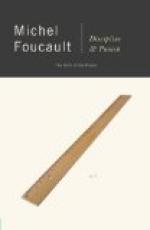|
This section contains 1,636 words (approx. 5 pages at 400 words per page) |

|
Summary
In this section, “Complete and austere institutions,” Foucault returns to the subject of the prison. While prisons became the main apparatus of punishment in the early nineteenth century, they were not innovative institutions. Namely, Foucault writes that prison models such as the one at Ghent and the Walnut Street Prison in Philadelphia, were not “new” in penal history. What was new was that the rising middle-class conceived of justice as representing the principle of equality, but it actually contained the covert mechanisms of “disciplinary subjection,” which already existed in society (232).
When the prison became the dominant form of punishment in the eighteenth century, it appeared as a “natural” and “self-evident” development. Foucault argues that the feeling that imprisonment was a rational move reflects the dominance of the middle-class, who propagated an idea of individual liberty as the benchmark of equality. The prison, then...
(read more from the Section 4, Part 1 Summary)
|
This section contains 1,636 words (approx. 5 pages at 400 words per page) |

|




